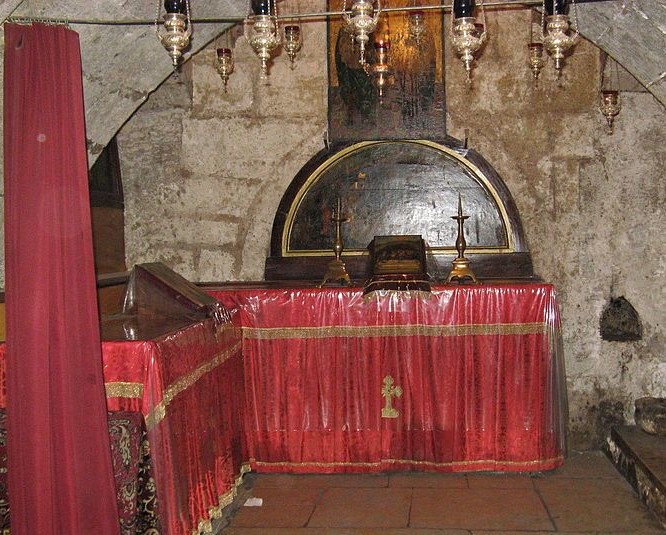Game of Thrones in the Kingdom of Jerusalem

The Tomb of Mary can be found near Gethsemane, in a cave located at the underground chapel of a crusader church that was destroyed hundreds of years ago. According to Christian tradition, Mary, mother of Jesus, was placed here after her death, before she ascended to heaven. The entrance to the site looks like something out of an Indiana Jones style action movie. A dark and cool staircase dating to the Crusader period leads down, deep underground, to a cross-shaped hall. The tomb is currently managed by the Greeks and Armenians, and has the look and feel of an oriental church, with the typical decorations, ornaments and smell of incense.
The Kingdom of Jerusalem was established by the Crusaders in 1099 after the conquest of the Land of Israel from the Muslims during the First Crusade. The kingdom survived for less than a hundred years, until its conquest in 1187 by Saladin, the founder of the Ayyubid dynasty. In 1192, the Second Kingdom of Jerusalem was established with its capital in Acre, which was conquered by the Mamluks in 1260. Acre itself continued to exist as the last Crusader outpost in the Holy Land until 1291.
Princess Melisende was born in 1105 as the eldest daughter of Baldwin II, the third king of the Kingdom of Jerusalem. Her mother was the Armenian princess Morphia of Melitene. Although her parents were married in a diplomatic marriage aimed to strengthen regional alliances, her father loved her mother very much and refused to divorce her even though they had only four daughters and not a single son who could serve as an heir.
Baldwin wanted to fortify Melisende's position as heir after his death. To this end, he turned to King Louis VI of France and asked him to match her with a strong ally. Louis chose Fulk V, an important French nobleman who was the count of Anjou in the Loire Valley. Fulk, himself a crusader who traveled to the Holy Land in 1120 to help fight against the Muslims, agreed to marry Melisende on the condition that he would receive equal status to his wife and the title "King of Jerusalem”. In 1129 Fulk returned to the Kingdom of Jerusalem and married Melisende, and in 1130 their son was born who would serve as King Baldwin III. Baldwin, Melisende's father, feared that the ambitious Fulk would dispossess his daughter after he died, so he crowned Melisende, Fulk, and their son Baldwin together, and declared Melisende the sole legal guardian of her son. After Baldwin's death in 1131, his fears were realized, and although Melinsada and Fulk initially came to power as joint rulers, her husband soon deposed her from the throne and remained a sole king. As part of the internal power struggles, Fulk accused Melinsada of adultery with Hugh, the count of Jaffa, who was one of the kingdom’s nobles and an opponent of the new king that was not part of the local aristocracy. Hugh started a rebellion against Fulk, but although he won a battle against the king's army he was not strong enough to overthrow him and was forced to go into exile. The anarchy in the royal court allowed Melisende and her supporters to stage a coup against Fulk, and Melisende regained the power of government. In 1136 Fulk and Melisende reconciled, and even had another son. In 1143 Fulk died in a hunting accident in Acre. Melisende remained the only queen, and although officially she served as regent for her son Baldwin III, in practice she ruled the kingdom all by herself. When Baldwin grew up and wanted to take an active part in government, his mother refused to give up her position. The conflict between Melisende and Baldwin intensified, until the council of nobles decided to divide the kingdom in two. Baldwin refused to accept the decision, gathered an army and conquered Jerusalem while his mother and brother fortified themselves in the city's citadel, which was located where the Tower of David is today. Through the mediation of the church, a reconciliation agreement was reached between the queen and her son, and they began to serve as joint rulers. Baldwin headed the army and was most of the time outside the borders of the kingdom, while Melisende managed internal affairs.
Melisende was a significant and influential crusader queen. She was an ally of the church, served as an important patron of art in the Crusader Kingdom, constructed many buildings, churches and monasteries, and left her mark on Jerusalem. After a turbulent life full of upheavals, Melisende died in 1161 and was buried in the Tomb of Mary. Her grave can still be found today in the chapel, to the right of the stairs.
During the British Mandate period, one of Jerusalem's streets was named after Melisande. During the 1950s, after the establishment of the State of Israel, its name was changed to Queen Heleni street. Heleni was the queen of Adiabene in Assyria, who converted to Judaism in the 1st century AD. She is mentioned in the Jewish sources as a righteous ruler who helped the poor of Israel, contributed to the Second Temple and built palaces and buildings in Jerusalem.

(Anecdote authored by: עמיר)
(Number of views: 51)
